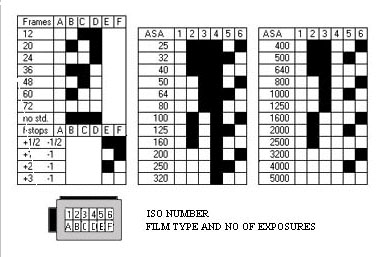Films are available in a variety of sensitivities, or speeds, denoted by International Standards Organization (ISO) ratings. The higher the rating, or ISO number, the faster the film reacts to light and the shorter the exposure required. Fast films are grainier and have reduced colour or black saturation. Slow films produce higher quality images but may need inconveniently long exposures. Those rated at ISO 100 and 200 are commonly used for daylight photography of people and everyday life. Exceptionally fast and very slow films are used in extreme conditions, and where particular qualities or effects are required. Most modern 35mm and APS film cassettes feature DX-coding, a chequer-board pattern used by cameras to set film speed automatically. This is essentially a bar code, with the silver areas being conductive and the black areas being insulated. It works in conjunction with the pin-like DX-contacts in a camera's film-cartridge chamber to sends film-speed and other data to a camera's CPU.
A film consists of one or more layers of emulsion containing light sensitive silver halide crystals coated onto a plastic base. A film having a thick coat of large silver crystals is more sensitive to light than one that has a thinner coat of smaller crystals, and is therefore considered "faster".
 After processing, an image is made up of millions of clumps of silver derived from developed crystals, or dyes in the case of colour film. These are referred to as grain. However, the larger grains within the emulsion of faster films soon become visible when images are substantially enlarged. An advantage of fast films is that shorter exposures are required, and in the case of hand-held shots this may result in sharper images. Slow films have a finer grain structure and consequently exhibit less granularity in even-toned parts of an image such as a clear sky. They nevertheless require longer exposure times and perhaps the use of a tripod to avoid camera movement. Grain is not, in itself, something to be feared. It is merely part of the process of image formation which should be taken into account when choosing film. Fast films are extremely useful, and grain can also be put to good pictorial effect.
After processing, an image is made up of millions of clumps of silver derived from developed crystals, or dyes in the case of colour film. These are referred to as grain. However, the larger grains within the emulsion of faster films soon become visible when images are substantially enlarged. An advantage of fast films is that shorter exposures are required, and in the case of hand-held shots this may result in sharper images. Slow films have a finer grain structure and consequently exhibit less granularity in even-toned parts of an image such as a clear sky. They nevertheless require longer exposure times and perhaps the use of a tripod to avoid camera movement. Grain is not, in itself, something to be feared. It is merely part of the process of image formation which should be taken into account when choosing film. Fast films are extremely useful, and grain can also be put to good pictorial effect.
It is undoubtedly worth standardizing on film stock. Every variety has slightly different exposure latitude, contrast, grain and so on, so sticking with one or two types helps to achieve an understanding of relevant characteristics. Some films also react in a non-linear manner when using exposures longer than one second. Consequently, doubling the exposure time has less effect than opening the aperture by one stop. This is known as reciprocity failure. A further consideration is that films have a shelf-life indicated by dates displayed on packaging. They should be used fresh, stored in a cool place and processed as soon as possible after exposure.






